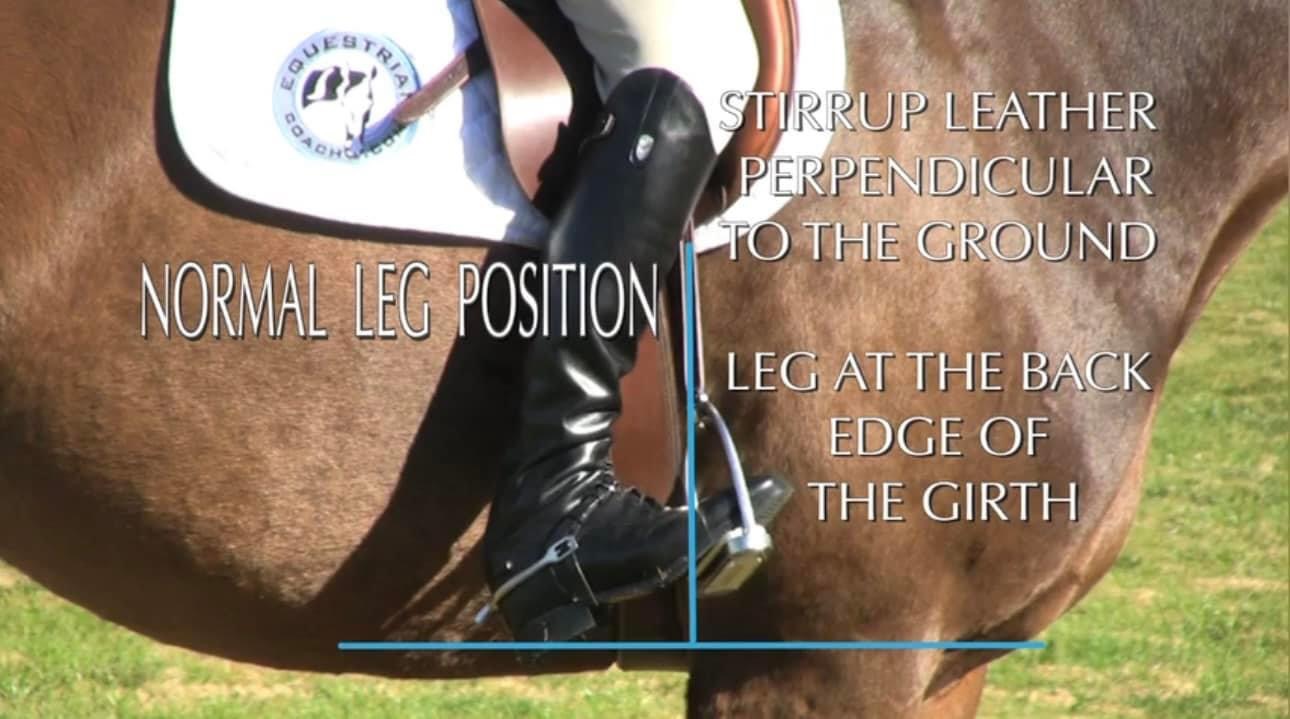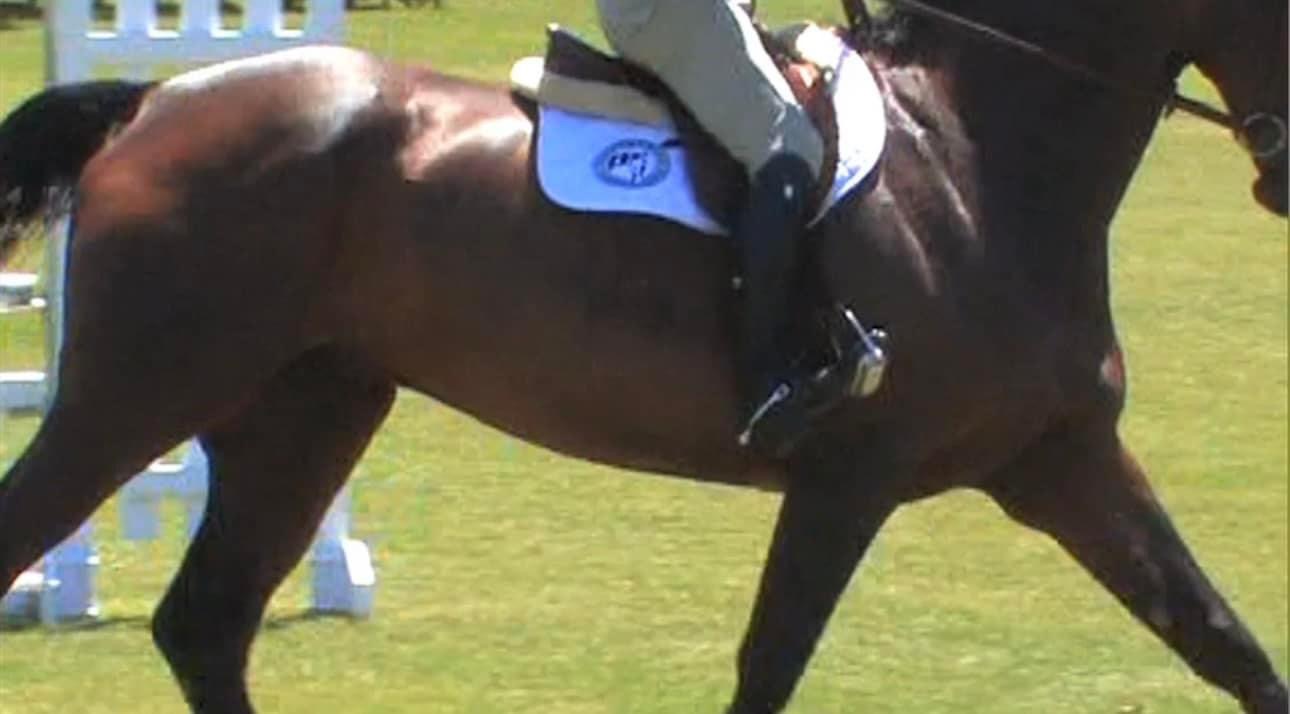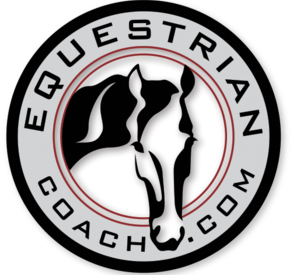The Three Leg Positions
In my clinics, the leg position of a rider is the first thing I notice and address before proceeding with further instruction. A solid foundation in the tack begins with the lower leg, and I am a huge advocate of the forward seat with proper leg position in the hunter/jumper discipline. The following will describe our three leg positions in riding: 1. The normal leg; 2. The displacing leg; 3. The braced or leveraged leg. It’s a common observation at my clinics that I find riders lacking the understanding and application of these three leg positions and many riders with a lower leg position too far behind the girth as their default placement.
Part One: The Normal Leg
One’s whole basis of support begins with the lower leg and the foot. The normal leg should be a rider’s default position and is described as the stirrup leather being perpendicular to the ground and the leg at the back edge of the girth. In my teaching, I prefer to say “at the girth” rather than at the back edge as I have found this to be a more helpful and productive description when helping riders understand the normal leg placement and to fix a lower leg that is too far behind the girth. There is some slight flexibility in either direction of the perpendicular depending on the conformation of the horse and rider, and the rider’s equipment. An experienced rider may develop a preference in either direction of the perpendicular: some prefer at the back edge of the girth, while others, as in my case, prefer slightly in front of the perpendicular.

The normal leg position is generally used for any impulse forward, as a holding leg (for example, to prevent a horse from cutting in), for some lateral movements, and to assist in the bend of the horse. The normal leg is a rider’s default lower leg position.

I have heard the notion that riders should align their ears, shoulders, hips, and heel, but I find this more so appropriate for the dressage discipline where collected gaits call for a more vertical upper body position and somewhat less heel depth as the rider’s balance is in the seat and not in the stirrups. In the jumping discipline, this alignment may be appropriate for the halt or backing, but should not be your default normal leg position alignment at faster gaits. In our hunter/jumper discipline, we must have the fluid ability to adjust our upper body position, hip angle, and seat. This ability is fostered by a solid lower leg foundation and a heel that acts as a shock absorber. Without the heel to act as a shock absorber and proper positioning of the lower leg, a rider’s seat is limited and will become the absorber, negatively affecting the comfort of the horse’s back and the rider’s position.

A common fault I find at clinics is the lack of heel depth and improper placement of the foot in the stirrup. The foot should be placed in the stirrup just over the ball or slightly in front of the ball should one have a less flexible ankle, and a toe angle of 10-30 degrees. Placing the foot too far in the stirrup makes it very difficult to establish heel depth and flexibility (unless you have incredible ankle mobility). So often I see heels level or barely down. As I mentioned previously, the ankle and heel are your shock absorbers. A rider should find a mid to deep heel range that allows for mobility and this shock-absorbing concept. This does NOT mean a heel so far down that it loses mobility and its purpose of acting as a spring.
I elaborate on proper leg position in great detail in this lesson, “Building Blocks to a Great Position, Part One.” Watch the Lesson
You can also improve the functionality of your lower leg with this range of motion exercise: View Exercise
Part Two: The Displacing Leg
Normally used between 2 – 4 inches behind the girth, the displacing leg generally influences the haunch. A rider may use the displacing leg position to control the haunches on a turn, for canter departures, maintaining a counter canter lead, haunches in, and, in some cases, flying changes.

All too often, I see riders with the displaced leg as their default leg position, riding consistently with their leg too far back behind the girth. This position is useful as an aid to influence the haunches of the horse, but should not be the rider’s default alignment as it hinders proper position and stability in the tack. The lower leg supports the upper body, and one inch too far back or too far forward makes a huge difference. As I went over in my previous post – Part One: the normal leg – in the hunter/jumper discipline, the ability of a rider to adjust one’s hip angle and upper body position is fostered by correct lower leg alignment and the heel to act as a shock absorber or spring.

I believe this “epidemic” of riders with their default lower leg position too far behind the girth – in a displacing leg position – is the result of a few factors. I think the introduction of warmbloods from the early y 80s and on has encouraged our lower leg to go further back as they require more leg than the thoroughbreds we used to ride. (Though, most warmbloods today are much lighter to ride than the ones that were introduced years ago.) Riding in sheepskin girths can also encourage a lower leg that is too far behind the girth. Most of these sheepskin girths are so thick that a rider can only communicate with the hairs of the horse if their leg is far behind the girth. And the design of some saddles today, in my opinion, do not allow for or encourage a correctly positioned and stable lower leg.
If you find yourself lacking lower leg mobility, I recommend watching this lesson: Range of Motion Exercise
Part Three: The Braced or Leveraged Leg
The brace leg position, where your toe may get slightly in front of your knee with a very deep heel, is handy to have in your tool chest for situations that arise that require you to be very secure in the tack. A rider may use the leveraged leg on a very strong horse, or in emergencies like sudden stops, stumbling, or runaways. The situation and its severity will determine the degree of brace a rider exhibits. It is important to be able to call on this lower leg position when the occasional situation presents itself.

The brace has a purpose, though it is not the norm nor something we use on a daily basis. It is important that a rider has the ability to push their heel down and toward the front of the horse under certain circumstances. The brace will help you stay secure in the tack if a horse were to stop. It provides a rider with leverage on a very strong horse or a horse that one has difficulty controlling. Some riders may learn this lower leg position naturally, while others may have to practice this to some degree. Either way, you want this in your tool chest!

You do not want to have just one leg position, especially one that is too far back. Developing greater lower leg mobility and range of motion is important not only to acquire and apply the three leg positions – normal, displaced, and braced – but also to create a solid foundation in the tack. Lack of mobility in a rider’s lower leg is seen all too often these days. I greatly encourage riders in my clinics to practice exercises that improve their lower leg mobility and functionality daily and to understand the three leg positions we have and their purpose.
Watch these videos to learn more:

